The Synth Page

This is the first page you will see when you open Evolution One. It is where you define and mix together the sound elements for your synth sound before using the features on the other pages to sculpt, modulate and perfect your sound.
Use these quick links to jump to a section.
Osc1, Osc2 and Mix
Waves are one of the ways in which energy is transferred. Waves can be described as oscillations or vibrations. Sound waves cause air particles to vibrate back and forth, moving out in all directions from their source at the speed of sound until those vibrations reach our ears, cause the eardrum to vibrate and are translated by our brains into the sounds we hear. The physical shape of the waveforms - the vibrations, the oscillations - give sounds their unique character. Indeed, if you zoom all the way into an audio track on the Arranger Screen, you will see the waveform and how it is vibrating or oscillating over time.
Classic hardware analog synthesizers generate sound waves using electronic Voltage Controlled Oscillators (VCO). Virtual analog synthesizers like Evolution One recreate these electronic oscillators as Digitally Controlled Oscillators (DCO).
Evolution One gives you five oscillators in total (Two DCO, FM, Sub and Noise) but here we concentrate on the controls for the two DCO.
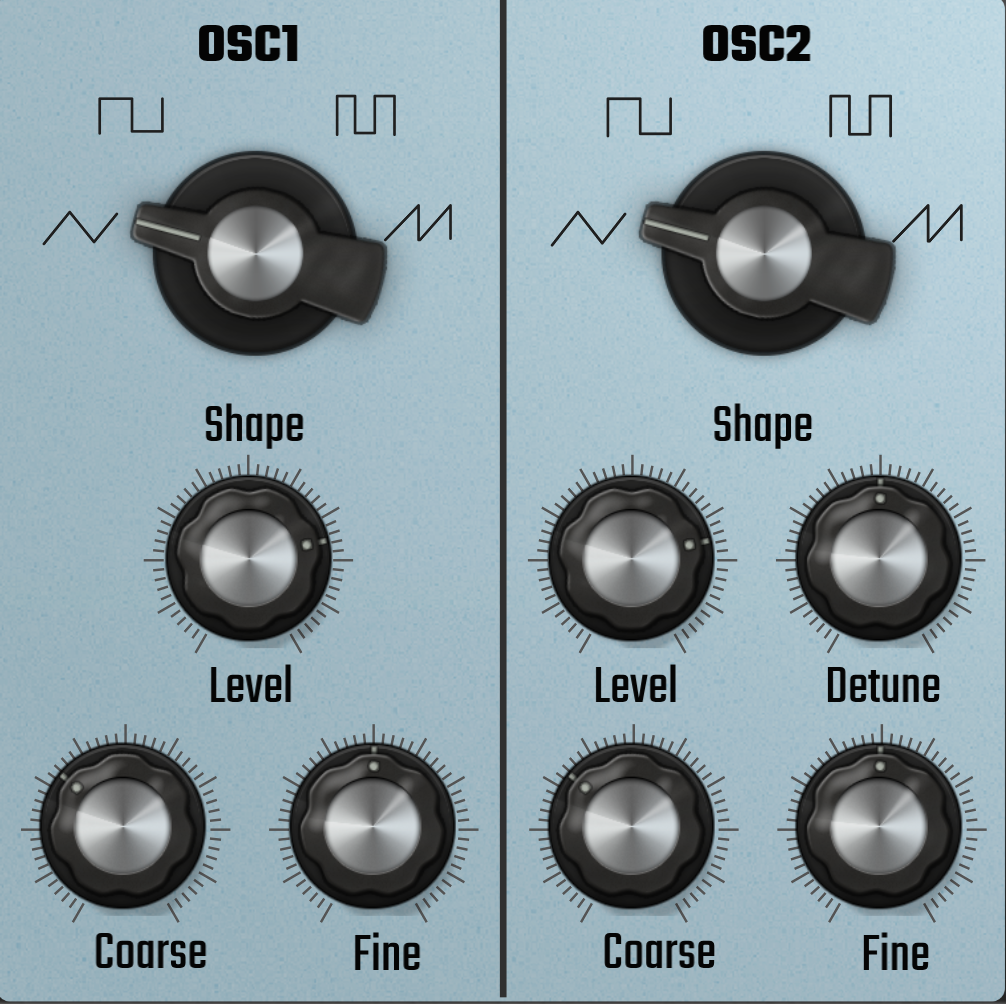
As can be seen, there are four main waveform shapes (Triangle ![]() , Square
, Square ![]() , Narrow Pulse
, Narrow Pulse ![]() and Sawtooth
and Sawtooth ![]() ) each with their own sound characteristics but this isn't the full story. Evolution One allows you to morph between the different waveform shapes as the Shape dial is moved. Activate the keyboard Hold function, press a key and move the dial around: you will hear the sound subtly change as the waveform constantly changes shape. This gives you much more scope for possible waveform shapes.
) each with their own sound characteristics but this isn't the full story. Evolution One allows you to morph between the different waveform shapes as the Shape dial is moved. Activate the keyboard Hold function, press a key and move the dial around: you will hear the sound subtly change as the waveform constantly changes shape. This gives you much more scope for possible waveform shapes.
Both oscillators allow you to define the Shape of your waveform, set its Level (loudness), control its Coarse tuning and its Fine tuning. Oscillator two also adds a Detune control.
Coarse tuning controls the note of the oscillator relative to the note pressed on the keyboard (or triggered on the piano roll). The default value is the same as the note triggered but it can be moved up or down in semitones (between -12 and +24) using the dial. The Playback Timer panel will display the semitone setting as the dial is moved. As always, double tap on the dial to return it to its default value. Try raising the second oscillator by an octave (12 semitones) or a fifth (7 semitones) for easy examples of what can be achieved with Coarse tuning.
Fine tuning controls the pitch of the oscillator relative to the Coarse tuning. This time the increments are much smaller than semitones though. They are called cents. Twelve tone equal temperament (the most commonly used musical system today) divides the octave into twelve semitones of 100 cents each. One approach to making a basic synth sound is to have two identical wave shapes and very slightly alter the Fine tuning of both: one of them tuned down (flat) and the other tuned up (sharp), both by the same small amount. Double tap to reset to default.
Oscillator 2 also has a Detune dial. The effect of the Detune dial might initially sound similar to altering the Fine tuning but it is actually different. Detune offsets the pitch (or frequency) of oscillator 2 by a value of Hertz (Hz) rather than the musically defined cents used by Fine tuning. In practice, the Detune algorithm gives more detune in the lower bass notes. It results in a thicker, chorus-like sound with a sense of 'beating' movement as oscillator 2's amount of detune interacts with oscillator 1. Double tap to reset to default.
The Level dials can be used to set the volume of each oscillator within your synth sound but you can also use the Mix dial, seen below, to control the ratio of Osc 1 to Osc 2 in the output.
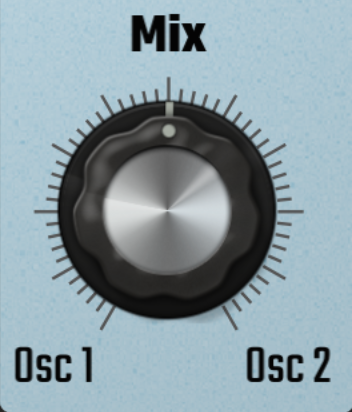
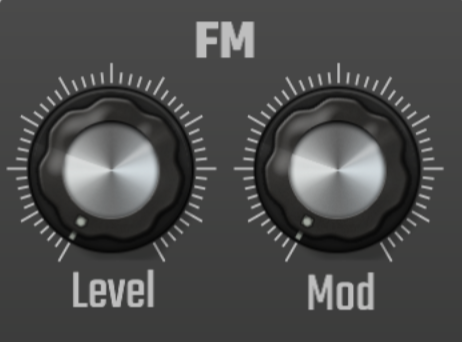
FM stands for Frequency Modulation. Evolution One provides what is referred to as an FM pair. This comprises of a Carrier signal (the signal to which the modulation is applied) and a Modulator (whose frequency modulation index modulates the frequency of the carrier signal). In this case, the process generates side band harmonics as the Mod is increased, resulting in a richer, brighter output waveform.
The Level dial controls the overall level of the FM oscillator.
The Mod dial controls the amount of Frequency Modulation applied to the carrier signal. If the Mod dial is all the way down, no modulation is applied and all that is heard is the carrier sine wave.
NOTE. Some of you may be surprised that Evolution One doesn't offer a Sine waveform in the oscillator section. However, this is because Evolution One has a sine wave 'hidden' in the FM panel. If you want just a sine wave, turn up the Level in the FM panel and keep the Mod dial (as well as the levels of all the other sound sources) all the way down.
Sub Osc
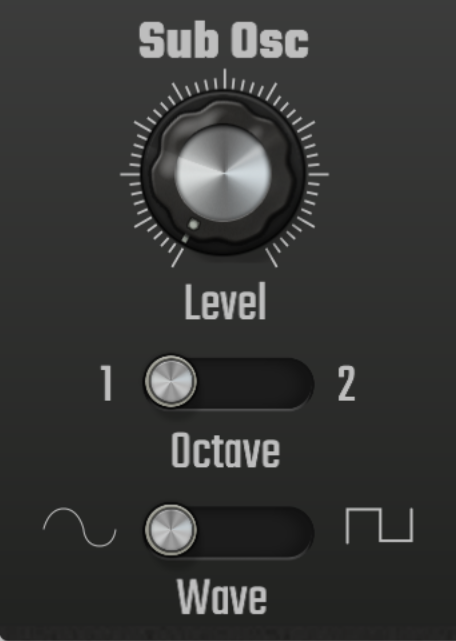
As already mentioned, there is a sine wave in the FM panel but Evolution One also offers a sine or square wave sub-oscillator. The sub-oscillator gives you an additional oscillator which plays at a fixed one or two octaves below the note triggered. This can give you a fuller, bass-rich sound when required.
The Level dial controls the volume level of the sub-oscillator.
The Octave selector allows you to select whether the sub-oscillator plays at one, or two octaves below the note triggered.
The Wave selector allows you to select whether your sub-oscillator is a Sine ![]() wave or a Square
wave or a Square ![]() wave.
wave.
Noise
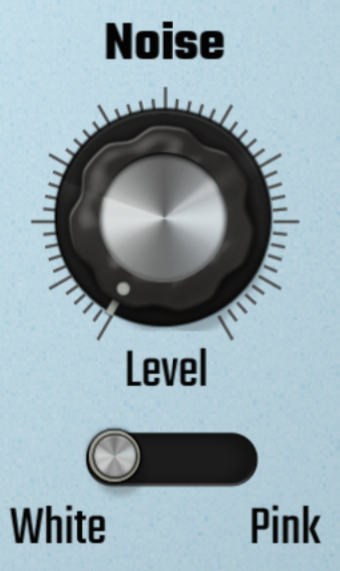
As we've established here, sound waves vibrate. The Shape of those waveform vibrations give sounds their unique timbre or character. The Frequency of those vibrations - how quickly the wave is vibrating per second - determines the pitch of the sound heard. Finally, the Amplitude - the maximum extent (or height) of vibration or oscillation measured from the mid-point - determines how loud the sound we hear is.
White Noise is an equal amplitude (loudness) of every frequency (pitch) the human ear can hear.
Pink Noise also contains every frequency the human ear can perceive but the higher frequencies have a lower amplitude than the lower frequencies resulting in a softer sound.
The Noise generator in Evolution One can be used on its own to produce interesting sounds and atmospheres when sculpted and modulated. But it can also be very useful if your synth sound is feeling a bit too digital, a bit too 'clean'. Vintage analog synths naturally produced a certain amount of hiss due to their electronic nature. Adding a small amount of noise to your synth sound might just give it what it's missing.
Use the Level dial to control the amount of noise present.
Portamento
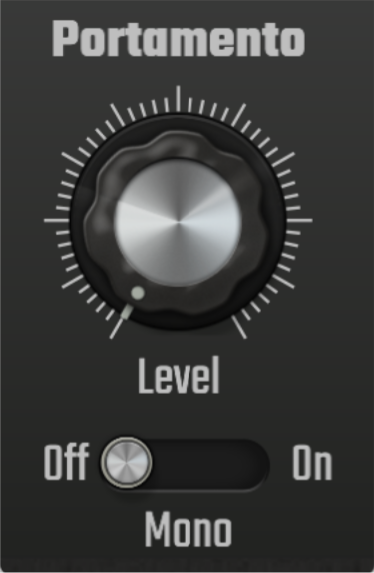
The Portamento panel allows you to switch Mono mode on and off and, when it's on, control the amount of portamento applied. Portamento is a slide, or glide, between notes.
Mono mode switches the synth from polyphonic mode, where a maximum of six notes can be played at the same time, to monophonic mode, where only one note can be played at a time. Please note, it doesn't change the audio output from a stereo signal to a mono signal - you can still apply spatial modulation and stereo effects like the Delay to presets with Mono switched on.
Use the On/Off switch to turn Mono mode on or off.
Use the Level dial to apply more or less portamento, slide, between notes. Portamento can only be applied when Mono mode is switched on.
Don't forget that Mono mode will be affected by your 'Mono is legato' status in the synth Settings. A description of Mono is Legato can be found here.
Master
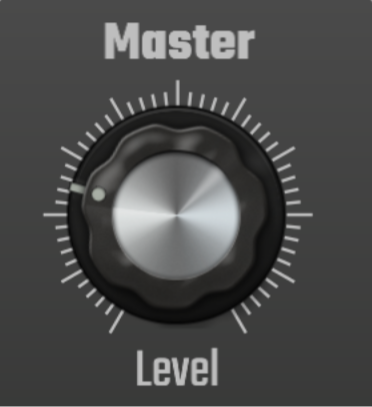
This panel controls the master output Level (volume) of the synth.